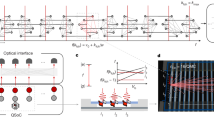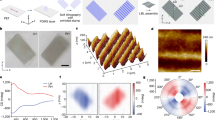Abstract
The idea of atomic-resolution holography has its roots in the X-ray work of Bragg1 and in Gabor's electron interference microscope2. Gabor's lensless microscope was not realized in his time, but over the past twelve years there has been a steady increase in the number of reports on atomic-resolution holography. All of this work involves the use of electrons3,4,5,6 or hard X-rays7,8,9,10,11 to produce the hologram. Neutrons are often unique among scattering probes in their interaction with materials: for example, the relative visibility of hydrogen and its isotopes is a great advantage in the study of polymers and biologically relevant materials. Recent work12 proposed that atomic-resolution holography could be achieved with thermal neutrons. Here we use monochromatic thermal neutrons, adopting the inside-source concept of Szöke13, to image planes of oxygen atoms located above and below a single hydrogen atom in the oxide mineral simpsonite14.
This is a preview of subscription content, access via your institution
Access options
Subscribe to this journal
Receive 51 print issues and online access
$199.00 per year
only $3.90 per issue
Buy this article
- Purchase on Springer Link
- Instant access to full article PDF
Prices may be subject to local taxes which are calculated during checkout




Similar content being viewed by others
References
Bragg, W. L. The X-ray microscope. Nature 149, 470 (1942).
Gabor, D. A new microscopic principle. Nature 161, 777–778 (1948).
Harp, G. R., Saldin, D. K. & Tonner, B. P. Atomic-resolution electron holography in solids with localised sources. Phys. Rev. Lett. 65, 1012–1015 (1990).
Zharnikov, M., Weinelt, M., Zebish, P., Stichler, M. & Steinrück, H.-P. First experimental determination of an adsorption site using multiple wave number photoelectron diffraction patterns. Phys. Rev. Lett. 73, 3548–3551 (1994).
Sieger, M. T., Roesler, J. M., Lin, D.-S., Miller, T. & Chiang, T.-C. Holography of Ge(111)-c(2×8) by surface core-level photoemission. Phys. Rev. Lett. 73, 3117–3120 (1994).
Orchowski, A., Rau, W. D. & Lichte, H. Electron holography surmounts resolution limit of electron microscopy. Phys. Rev. Lett. 74, 399–402 (1995).
Tegze, M. & Faigel, G. Atomic-resolution X-ray holography. Europhys. Lett. 16, 41–46 (1991).
Gog, T. et al. Multiple-energy X-ray holography: atomic images of hematite (Fe2O3). Phys. Rev. Lett. 76, 3132–3135 (1996).
Tegze, M. & Faigel, G. X-ray holography with atomic resolution. Nature 380, 49–51 (1996).
Tegze, M., Faigel, G., Marchesini, S., Belakhovsky, M. & Chumakov, A. I. Three dimensional imaging of atoms with isotropic 0.5 Å resolution. Phys. Rev. Lett. 82, 4847–4850 (1999).
Bompadre, S. G., Petersen, T. W. & Sorensen, L. B. Tabletop Bremsstrahlung X-ray holography: making multiwavelength X-ray holograms. Phys. Rev. Lett. 83, 2741–2744 (1999).
Cser, L., Krexner, G. & Török, Gy. Atomic-resolution neutron holography. Europhys. Lett. 54(6), 747–752 (2001).
Szöke, A. in Short Wavelength Coherent Radiation: Generation and Applications, Proc. Topical Meeting (eds Attwood, T. & Boker, J.) 361–467 (AIP Conf. Proc. No. 147, American Institute of Physics, New York, 1986).
Bowley, H. Simpsonite (sp. nov.) from Tabba Tabba, western Australia. J. R. Soc. W. Aust. 25, 89–92 (1939).
Faigel, G. & Tegze, M. X-ray holography. Rep. Prog. Phys. 62, 355–393 (1999).
Taylor, L. E. R. X-ray studies of Simpsonite. J. R. Soc. W. Aust. 25, 93–97 (1939).
Ecrit, T. S., Černý, P. & Hawthorne, F. C. The crystal chemistry of Simpsonite. Can. Mineral. 30, 663–671 (1992).
Barton, J. J. Removing multiple scattering and twin images from holographic images. Phys. Rev. Lett. 67, 3106–3109 (1991).
Sears, V. F. Neutron scattering lengths and cross sections. Neutron News 3, 26–37 (1992).
Henderson, R. The potential and limitations of neutrons, electrons and X-rays for atomic-resolution microscopy of unstained biological molecules. Q. Rev. Biophys. 28, 171–193 (1995).
Weik, M. et al. Specific chemical and structural damage to proteins produced by synchrotron radiation. Proc. Natl Acad. Sci. USA 97, 623–628 (2000).
Spence, J. Holograms of atoms. Nature 410, 1037–1040 (2001).
Acknowledgements
We acknowledge the intellectual contributions of I. P. Swainson and the expert technical assistance of J. H. Fox and L. E. McEwan. We also thank T. S. Ecrit for providing the simpsonite crystal.
Author information
Authors and Affiliations
Corresponding author
Rights and permissions
About this article
Cite this article
Sur, B., Rogge, R., Hammond, R. et al. Atomic structure holography using thermal neutrons. Nature 414, 525–527 (2001). https://doi.org/10.1038/35107026
Received:
Accepted:
Issue Date:
DOI: https://doi.org/10.1038/35107026
This article is cited by
-
Orbital angular momentum holography for high-security encryption
Nature Photonics (2020)
Comments
By submitting a comment you agree to abide by our Terms and Community Guidelines. If you find something abusive or that does not comply with our terms or guidelines please flag it as inappropriate.



